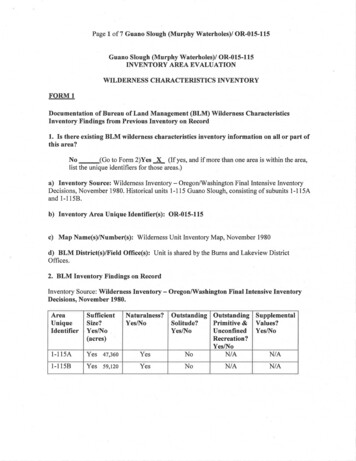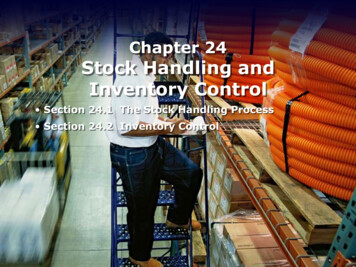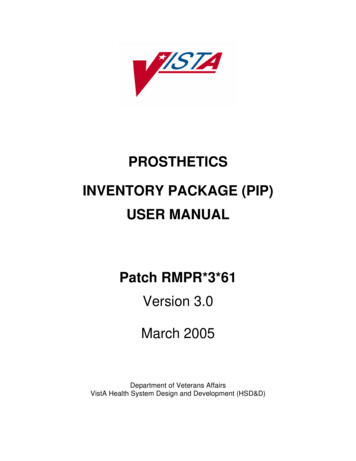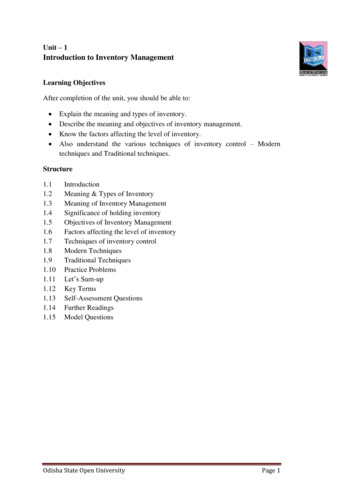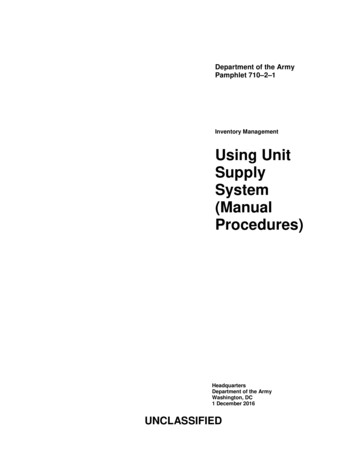
Transcription
Department of the ArmyPamphlet 710–2–1Inventory ManagementUsing rtment of the ArmyWashington, DC1 December 2016UNCLASSIFIED
SUMMARY of CHANGEDA PAM 710–2–1Using Unit Supply System (Manual Procedures)This major revision, dated 1 December 2016—oIncorporates dual signature requirements for DA Form 1687 (para 2–28f(4)).oRevises requirements for automation accountability (para 4–38).oUpdates total package fielding procedures (para 4–42).oRevises shop stock management (chap 8).oUpdates sensitive items and controlled cryptographic items based on AR 710–2 (para 9–9).oClarifies the quarterly sensitive items inventory (para 9–9).oRevises petroleum management (chap 11).oRemoves prescribed load list 300-line limit (throughout).oMoves ammunition management to DA Pam 700–16 (throughout).oRevises communication security procedures (throughout).oEliminates CBS–X reporting requirement (throughout).
HeadquartersDepartment of the ArmyWashington, DC1 December 2016*Department of the ArmyPamphlet 710–2–1Inventory ManagementUsing Unit Supply System (Manual Procedures)Applicability. This regulation appliesto the Active Army, the Army NationalGuard/Army National Guard of the UnitedStates, and the U.S. Army Reserve, unlessotherwise stated. During mobilization,chapters and policies contained in this regulation may be modified by the proponent.Proponent and exception authority.The proponent of this pamphlet is the Deputy Chief of Staff, G–4. The proponent hasthe authority to approve exceptions orwaivers to this pamphlet that are consistentwith controlling law and regulations. TheHistory. This publication is a major revi- proponent may delegate this approval authority, in writing, to a division chief withinsion.the proponent agency or its direct reportingSummary. This pamphlet provides unit unit or field operating agency in the gradeand/or organization manual supply proce- of colonel or the civilian equivalent. Activities may request a waiver to this pamphletdures.by providing justification that includes afull analysis of the expected benefits andmust include formal review by the activity’s senior legal officer. All waiver requests will be endorsed by the commanderor senior leader of the requesting activityand forwarded through higher headquartersto the policy proponent. Refer to AR 25–30for specific guidance.Suggestedimprovements. Usersare invited to send comments and suggestedimprovements on DA Form 2028 (Recommended Changes to Publications and BlankForms) directly to the Deputy Chief ofStaff, G–4 (DALO–SP), 500 Army Pentagon, Washington, DC 20310–0500.Distribution. This publication is available in electronic media only and is intended for command levels A, B, C, D, andE for the Active Army, the Army NationalGuard/Army National Guard of the UnitedStates, and the U.S. Army Reserve.Contents (Listed by paragraph and page number)Chapter 1General, page 1Purpose 1–1, page 1References 1–2, page 1Explanation of abbreviations and terms 1–3, page 1Requesting clarification and deviation of authority 1–4, page 1Nonapplicability of special items 1–5, page 1Requesting an accounting waiver 1–6, page 1Unit identification code and Department of Defense activity address code changes to property accounts 1–7, page 1General instructions for using this pamphlet 1–8, page 2Chapter 2Requesting and Receiving Supplies, page 2Section IRequesting Supplies, page 2General 2–1, page 2The Uniform Materiel Movement and Issue Priority System 2–2, page 2Control of priority designator utilization 2–3, page 3The required delivery date 2–4, page 4End item codes 2–5, page 4*This pamphlet supersedes DA Pam 710–2–1, dated 31 December 1997.DA PAM 710–2–1 1 December 2016UNCLASSIFIEDi
Contents—ContinuedForms used to request supplies 2–6, page 5Preparation of DA Form 2765–1 2–7, page 5Preparation of DA Form 3161 when used as a request for issue 2–8, page 5Preparation of DA Form 581 when used as a request for issue 2–9, page 5Preparation of DD Form 1348–6 as a request for issue 2–10, page 6Section IISpecial Request Instructions, page 6Requests for recoverable or nonexpendable components 2–11, page 6Capable and anticipated not mission capable supply 2–12, page 8Modification work order and modification kits 2–13, page 8Classified communication security items 2–14, page 9Requests for items in addition to authorized allowances 2–15, page 9Preparation for overseas movement requests 2–16, page 9Requests for construction-type equipment 2–17, page 9Request for repair parts in support of commercial construction equipment , materiel handling equipment , and commercial vehicles or commercial design tactical vehicles 2–18, page 9Requests for medical items 2–19, page 9Exception data requests 2–20, page 9Section IIIDocument Register, Supply Status, and Due-In Status File Procedures, page 10Keeping DA Form 2064/electronically generated DA Form 2064 2–21, page 10Supply status 2–22, page 13Section IVFollow-up, Cancellation, Modification, and Reconciliation Procedures, page 14Follow-up procedures 2–23, page 14Follow up on a shipment (request for transportation status) 2–24, page 16Cancellation procedures 2–25, page 16Modification of previously submitted requests 2–26, page 16Reconciliation or validation of supply requests 2–27, page 17Section VReceiving Supplies, page 18Authorization to request or receipt for supplies 2–28, page 18Receipt documents 2–29, page 19Recovered property 2–30, page 20Chapter 3Disposition of Property, page 20Section ITurn-in Procedures, page 20When property is turned in 3–1, page 20Where property is turned in 3–2, page 20Forms used for turn-ins 3–3, page 21Section IISpecial Turn-In Instructions, page 21Turn-in of property book and nonexpendable items 3–4, page 21Reporting and turn-in of classified communication security materiel 3–5, page 23Turn-in of expendable and durable supplies 3–6, page 23Disposal of batteries 3–7, page 23Turn-in of “found on installation” property 3–8, page 24Turn-in of temporary loan materiel 3–9, page 24Turn-in of returnable containers 3–10, page 24iiDA PAM 710–2–1 1 December 2016
Contents—ContinuedReturn of discrepant shipments 3–11, page 24Return of property issued to support DA-approved emergency requirements 3–12, page 25Turn-in of parachutes and components 3–13, page 25Turn-in information management processing equipment items 3–14, page 25Return of items to the self-service supply center 3–15, page 25Product Quality Deficiency Reports Exhibit Return Program 3–16, page 25Section IIILateral Transfer of Property, page 26Transfer approval 3–17, page 26Transfer procedures 3–18, page 26Transfer of organizational clothing and individual equipment when a unit moves 3–19, page 28Substitution procedures 3–20, page 28Chapter 4Accounting for Property, page 29Section IProperty Book Accounting, page 29Items that require property book accounting 4–1, page 29Other on-hand items 4–2, page 30Types of property 4–3, page 30Organization of the property book 4–4, page 30Appointing the property book officer 4–5, page 30Transfer of accountability 4–6, page 31Preparation of property book records 4–7, page 31Preparation of property book pages for substitute items 4–8, page 33Posting accounting data on DA Form 3328 4–9, page 34Posting management data on DA Form 3328 4–10, page 34Posting entries on DA Form 3328–1 4–11, page 35Correcting entries to property book pages 4–12, page 35Remaking property book pages 4–13, page 36Converting to an automated property accounting system 4–14, page 36Disposition of property book pages 4–15, page 36Keeping the supporting document files 4–16, page 36Lost, stolen or destroyed property books 4–17, page 37Closing the property book account 4–18, page 37Section IIMinor Property Book Adjustments, page 37Discrepancies in makes, models, sizes or obvious errors in serial numbers 4–19, page 37National stock number changes 4–20, page 37Unit of issue changes that affect the balance on hand 4–21, page 38Change in accounting requirements (accountable to nonaccountable) 4–22, page 39Change in accounting requirements (nonaccountable to accountable) 4–23, page 39Assembly of an end item 4–24, page 39Disassembly of an end item 4–25, page 40Consumption of class I, II, III, basic loads or class V combat load 4–26, page 40Small arms serial number registration and reporting 4–27, page 41Section IIISpecial Accounting Procedures, page 41Negotiable media 4–28, page 41Disposition of aviation fuel identaplates 4–29, page 42Items obtained from Defense Logistics Agency Disposition Services through the supply support activity 4–30, page 42Temporary assets 4–31, page 42Semitrailers of motor transport units 4–32, page 42DA PAM 710–2–1 1 December 2016iii
Contents—ContinuedMedical assemblies and equipment sets 4–33, page 43Support items authorized separately 4–34, page 43Accounting for field wire in the Army National Guard 4–35, page 43Accounting for commercial leased vehicles 4–36, page 43Accounting for General Services Administration long-term assignment vehicles under interagency fleet managementsystem 4–37, page 44Accounting for information management processing equipment 4–38, page 44Assigning responsibility for lease property other than information management processing equipment 4–39, page 45Accounting for chaplain kits and other nonexpendable, nonrecoverable, ecclesiastical supplies 4–40, page 45Accounting for system furniture 4–41, page 45Total package fielding 4–42, page 46Air delivery material 4–43, page 46Confiscated property 4–44, page 46Chapter 5Assigning Responsibility for Property, page 46Overview 5–1, page 46The property book 5–2, page 47Hand receipt procedures 5–3, page 47Temporary hand receipt procedures 5–4, page 50Temporary loan of Army National Guard and U.S. Army Reserve equipment to the active component 5–5, page 52Use of DA Form 3749 (Equipment Receipt) 5–6, page 52Management of property by use of an inventory list 5–7, page 53Chapter 6Controlling Components of End Items, page 54Hand-receipt annex procedures 6–1, page 54Component hand-receipt procedures 6–2, page 55Tool room procedures 6–3, page 57Cash sales of hand tools 6–4, page 59Chapter 7Management of Basic and Operational Loads, page 59General 7–1, page 59Basic loads of class I, II, III, IV, V (ammunition combat load), and VIII (except medical repair parts) supplies 7–2, page 59Basic loads of class II (durable and expendable), III, IV, and VIII (except medical repair parts) supplies 7–3, page 59Operational load of class I supplies 7–4, page 61Operational loads of class II, III(P), IV, and VIII (except medical repair parts) supplies 7–5, page 62Operational load of class III (bulk) supplies 7–6, page 62Chapter 8Repair Parts Procedures, page 63Overview 8–1, page 63Units authorized shop stock 8–2, page 63Communications security maintenance activity shop stock 8–3, page 63Location of shop stock and records 8–4, page 63Initial shop stock stockage for newly activated units and units having changes in assigned equipment 8–5, page 63Initial mandatory parts lists 8–6, page 64Updating shop stock records when initial mandatory parts lists are received 8–7, page 64Preparing, processing, and updating DA Form 2063–R 8–8, page 65Preparing request documents 8–9, page 65Requests for shop stock items 8–10, page 65Forecasting shop stock requirements 8–11, page 65Reparable management 8–12, page 65Posting the DA Form 2064 8–13, page 65ivDA PAM 710–2–1 1 December 2016
Contents—ContinuedKeeping the due-in status file 8–14, page 66Follow-up, cancellation, and modification of requests 8–15, page 66Reconciliation and validation of supply requests with the supply support activity 8–16, page 66Preparing and maintaining DA Form 3318 8–17, page 66Review of DA Form 3318 and inventory of the shop stock 8–18, page 66Keeping the nonstocked item demand file 8–19, page 67How to determine initial stockage level for a demand supported item 8–20, page 68Adjusting shop stock authorized stockage quantities 8–21, page 68Deletion and retention of shop stock items 8–22, page 68Chapter 9Inspection and Inventory Procedures, page 69Section IInspection and inventory approach, page 69Command inspections 9–1, page 69Receipt and issue of property inventory 9–2, page 70Change of hand receipt holder inventory 9–3, page 70Change of responsible official in the U.S. Army Reserve 9–4, page 71Tool room inventory 9–5, page 71Annual or cyclic inventory 9–6, page 71Change of property book officer inventory 9–7, page 73Annual property book officer inventory 9–8, page 74Sensitive item inventory 9–9, page 76Weapons and ammunition inventories 9–10, page 77Special inventory procedures for classified communication security equipment 9–11, page 78Annual central issue facility property book inventory 9–12, page 78Section IIArmy National Guard Reconciliation Procedures, page 81United States Property and Fiscal Office reconciliation 9–13, page 81Reconciliation reports 9–14, page 81Chapter 10Organizational Clothing and Individual Equipment Procedures, page 81General 10–1, page 81Items authorized for stockage 10–2, page 82Computing stockage at an organizational clothing and individual equipment issue point 10–3, page 82Classification of organizational clothing and individual equipment 10–4, page 82Organizational clothing and individual equipment property book procedures 10–5, page 82Organizational clothing and equipment records 10–6, page 83Summary procedures 10–7, page 84Issue procedures (in-processing) 10–8, page 85Camouflage maternity uniforms 10–9, page 86Turn-in procedures (out-processing) 10–10, page 87Other issues and turn-ins 10–11, page 87Lost, damaged, and destroyed organizational clothing and individual equipment (other than fair wear and tear) 10–12, page 88Cash collections of organizational clothing and individual equipment to replace lost, damaged, or destroyed organizational clothing and individual equipment 10–13, page 88Exchange procedures 10–14, page 89Reconciliation of organizational clothing and individual equipment records with documented personnel losses 10–15, page 90Organizational clothing and individual equipment property book inventory 10–16, page 90Organizational clothing and individual equipment record inventory 10–17, page 90Transfer of organizational clothing and individual equipment to and from central issue facilities 10–18, page 91DA PAM 710–2–1 1 December 2016v
Contents—ContinuedClosing the property book account 10–19, page 91Aviation central issue facility 10–20, page 91Clothing and equipment issued for Army National Guard air weather flight personnel 10–21, page 92Chapter 11Petroleum Management, page 92Section IOff-Post Purchase or Procurement of Petroleum Products for Convoy and Vehicle Refueling, page 92Use of military installations 11–1, page 92Use of local purchase 11–2, page 92Purchase or procurement of aviation products 11–3, page 92Use of Defense Logistics Agency energy contracts 11–4, page 92Use of fleet fuel commercial charge card 11–5, page 93Section IIInstructions for obtaining and using commercial fuel cards, page 93Obtaining a commercial fuel card 11–6, page 93Using and securing commercial fuel cards 11–7, page 93Use of DD Form 1898 (Energy Sale Slip) 11–8, page 94Section IIIBulk Petroleum, page 96Bulk petroleum accountability 11–9, page 96Appointment of responsible official and approving officer 11–10, page 96Customer or using unit control of bulk petroleum 11–11, page 97Use of DA Form 3643 11–12, page 99Use of DA Form 3644 11–13, page 101Use of DD Form 2921 and DD Form 2921–C 11–14, page 101Use of DD Form 1348–8 11–15, page 101Use of DD Form 2920 (DOD MILSPETS Transfer of Account Document) 11–16, page 101Causative research 11–17, page 101Automated fuel dispensing systems 11–18, page 101Bulk fuel storage tanks 11–19, page 103Section IVAllowable Losses or Gains for Bulk Petroleum, page 104Losses or gains as management guides for Army-owned bulk petroleum products 11–20, page 104Computation of losses or gains allowances 11–21, page 104Section VOrdering and Receiving Procedures for Bulk Petroleum Products from Commercial Sources, page 105Ordering procedures 11–22, page 105Controls required to receive bulk petroleum from commercial contractors 11–23, page 105Quantity determination: forward operating base destination 11–24, page 106Section VIQuality Surveillance Procedures, page 107Packaged petroleum products 11–25, page 107Packaged petroleum products shelf life 11–26, page 108Bulk storage tanks 11–27, page 110Bulk petroleum products purchased in the continental United States 11–28, page 113Filter/Separator effectiveness 11–29, page 114Sample tags (DD Form 2927) 11–30, page 115Sample submission log 11–31, page 115viDA PAM 710–2–1 1 December 2016
Contents—ContinuedSection VIIRequirements submission, page 115Estimated requirements for petroleum products for contract bulletins and all other purchase programs according to thesubmission schedule published by U.S. Army Petroleum Center 11–32, page 115Methods of requirements submission 11–33, page 115Requirement revision 11–34, page 115Mobilization or activation requirements 11–35, page 115Section VIIIFuel infrastructure engineering support, page 116The U.S. Army Petroleum Center is the Army Service control point 11–36, page 116Defense Logistics Agency Energy support of Army facilities holding capitalized fuel 11–37, page 117Army petroleum military construction program 11–38, page 118Fuel facility optimization program 11–39, page 119Section IXSupply support activity supply points, page 119Accounting for bulk petroleum 11–40, page 119Engineering technical review program 11–41, page 119Chapter 12Hazardous Material Management Program, page 120General 12–1, page 120Hazardous material management for material used in daily operations 12–2, page 120Basic loads of hazardous material 12–3, page 120Reporting on-hand quantities of hazardous material 12–4, page 120Requesting issue and turn-in of hazardous material 12–5, page 121Local purchase of hazardous material 12–6, page 121AppendixesA. References, page 122B. Advice Codes, page 128C. Status or Rejection Codes (AR 725–50), page 129D. Mode of Shipment Codes, page 132E. Type of Requirement Codes, page 133F.Return Advice Codes, page 135G. Julian Date Calendar, page 136H. MILSTRIP standard requisitioning and issue procedures document identifier codes, page 141I. Sensitive Item Supply Management, page 143Table ListTable 2–1: Priority designator table (relating force or activity urgency of need designator, page 3Table 2–2: Completion instructions (by block) for DA Form 2765–1 (Request for turn-in or issue), page 4Table 2–3: Forms used to request supplies, page 5Table 2–4: Completion instructions (by block) for DA Form 3161 as a request for issue, page 6Table 2–5: Completion instructions (by block) DD Form 1348–6 as a request for issue for a non-national stock numberitem, page 7Table 2–6: Completion instructions (by block) for DD Form 1348–6 as a request for issue for a national stock numberitem, page 7Table 2–7: Completion instructions (by block) for DA Form 2765–1 (Supply Status Card, document identifier codeAE1), page 14DA PAM 710–2–1 1 December 2016vii
Contents—ContinuedTable 2–8: Completion instructions (by block) for DA Form 2765–1 (Supply Status Card, document identifier codeAS1), page 15Table 2–9: Completion instructions (by block) for DA Form 2765–1 (Shipment Status Card, document identifier codeAU1 reply to cancellation request), page 15Table 2–10: Completion instructions (by block) for DA Form 1687, page 19Table 3–1: Forms used for turn-in, page 21Table 3–2: Completion instructions (by block) for DA Form 2765–1 request for turn-in, page 22Table 3–3: Completion instructions (by block) for DA Form 3161 as a lateral transfer, page 26Table 4–1: Completion instructions (by block) for DA Form 3328, page 33Table 4–2: Sample DA Form 3328–1, page 33Table 5–1: Completion instructions (by block) for DA Form 2062 prepared as a hand or subhand receipt, page 48Table 5–2: Completion instructions (by block) for DA Form 3161 prepared as a change document, page 49Table 5–3: Completion instructions for completing DA Form 3161 as a change document, page 50Table 5–4: Completion instructions (by block) for DA Form 3749 prepared as a change document, page 53Table 5–5: Completion instructions (by block) for DA Form 2062 prepared as an inventory list, page 53Table 6–1: Completion instructions (by block) for DA Form 2062 for hand receipt annex, page 55Table 6–2: Completion instructions (by block) for DA Form 2062 for component hand receipt, page 55Table 6–3: Completion instructions (by block) for DA Form 2062 for hand receipt with end item components, page 56Table 7–1: Completion instructions (by block) for DA Form 2063–R, page 60Table 7–2: Completion instructions (by block) for DA Form 2063–R, page 60Table 7–3: Completion instructions (by block) for DA Form 3318 for a class II, IV, or VIII basic load items, page 62Table 8–1: Completion instructions(by block) for DA Form 3318, sample of record of demands, page 66Table 9–1: , page 80Table 10–1: Completion instructions (by block) for DA Form 3328—Reverse Side, page 83Table 10–2: Organizational clothing and individual equipment record to assign responsibility for organized clothing andindividual equipment, page 84Table 10–3: Organizational clothing and individual equipment transaction summary, page 84Table 11–1: Information, page 93Table 11–2: Completion instructions(by block) for DA Form 5830–R , page 94Table 11–3: DA Form 3644, page 96Table 11–4: Completion instructions (by block) for DA Form 3643, page 100Table 11–5: Completion instructions (by block) for DA Form 3857, page 106Table 11–6: Completion instructions (by block) for DA Form 1300–4, page 107Table 11–7: Shelf-life code, page 108Table 11–8: Completion instructions (by block) for DA Form 5832–R, page 110Table 11–9: Storage tank sampling frequency, page 110Table 11–10: Completion instructions (by block) for DD Form 2927, page 110Table 11–11: Sampling containers, page 113Table 11–12: Completion instructions (by block) for the semiannual tank status report, page 117Table 11–13: Completion instructions (by block) for the tanks facility data sheet, page 117Table B–1: Advice codes for customer requests, page 128Table C–1: Type of requirement codes and explanations, page 129Table D–1: Mode of Shipment Codes and Explanations, page 132Table E–1: Type of requirement code explanation, 2nd position, page 133Table E–2: Type of requirement code explanation*—3rd position, page 133Table F–1: Return advice codes and explanations, page 135Table H–1: Document identifier codes, page 141Figure ListFigure 2–1: Completion instructions (by block) for DA Form 2064 actions, page 13Figure 2–1: Completion instructions (by block) for DA Form 2064 actions—Continued, page 13Figure 4–1: Sample DA Form 3328, showing entries for a substitute item, page 34Figure 9–1: Sample memorandum for cyclic inventory, page 73Figure 9–2: Sample of a memorandum reporting annual property book inventory results, page 76Figure 11–1: Samples of DD Form 1898 and DD Form 1896, page 95viiiDA PAM 710–2–1 1 December 2016
Contents—ContinuedFigure 11–2: Sample Responsible Official/Approving Officer Appointment Memo, page 99Figure 11–2: Sample responsible official/approving officer appointment memo---continued, page 99Figure 11–2: Sample responsible official/approving officer appointment memo---continued, page 99Figure 11–3: Basic Guide for Conducting Causative Research, page 103Figure 11–4: Outside the continental United States storage tank sample submission schedule, page 113Figure 11–4: Outside the continental United States storage tank sample submission schedule—Continued, page 113Figure G–1: Julian date calendar perpetual, page 137Figure G–2: Julian date calendar for leap years only, page 139GlossaryDA PAM 710–2–1 1 December 2016ix
Chapter 1General1–1. PurposeThis pamphlet provides procedures for manually requesting, receiving, accounting for, issuing, and turning in supplies.1–2. ReferencesSee appendix A.1–3. Explanation of abbreviations and termsSee the glossary.1–4. Requesting clarification and deviation of authoritya. Use the chain of command to request clarification of this pamphlet as follows—(1) Use a memorandum when making a written request for clarification. Include in the letter the following:(a) Page and paragraph number in question.(b) Name and defense switched network (DSN) or commercial phone number of the requestor.(c) Each element in the chain of command receiving a clarification request will try to answer it. If it cannot be answered,send the request to the next higher element. This will ensure that available talent is used and that the quickest possibleanswers are given.(2) When Department of the Army (DA) clarification is necessary, Army commands (ACOMs), Army service component commands (ASCCs), and direct reporting units (DRUs) will send clarification requests to: Commandant, U.S. ArmyQuartermaster School (ATSM–CG), 1201 Adams Avenue Fort Lee, VA 23801–2102.b. Deviation from the procedures in this pamphlet will only be made with prior approval of the Deputy Chief of Staff(DCS), G–4. Use the guidance in AR 735–5 to prepare and process requests for deviation from accounting procedures.Request for deviation should explain the need for a deviation, how long it will last, how the waiver will help accomplishthe mission, and how the end results will be measured. The request should include an opinion by the ACOM/ASCC/DRUlegal officer. Send all requests for deviation through command channels to DCS, G–4 (DALO–SP), Washington, DC20310–0500.1–5. Nonapplicability of special itemsa. Unless specified by prescribing directives, this pamphlet does not apply when an Army element is accounting for thefollowing items:(1) Army museums, historical artifacts, and art; see AR 870–20.(2) Army national cemeteries; see AR 290–5.(3) Issue and sale of personal clothing; see AR 700–84.(4) Safeguarding and controlling communications security material; see AR 380–40 and technical bulletin (TB) 380–41.(5) Accounting for library materials; see AR 735–17.(6) Nonstandard materiel policy and intelligence procedures; see AR 381–143.(7) Supplies on stock record accounts, except for class V supplies.b. This pamphlet will be used in peacetime and wartime when operating using manual procedures. Theater of operationscommanders will give implementing instructions as needed when the Secretary of the Army suspends any or all of thispamphlet.1–6. Requesting an accounting waiverUse the guidance in AR 735–5 to request a property accounting waiver. Send requests through command channels to DCS,G–4 (DALO–SP), Washington, DC 20310.1–7. Unit identification code and Department of Defense activity address code changes to propertyaccountsWhen a parent unit maintaining a property book is notified that the unit identification code (UIC) and Department ofDefense Activity Address Code (DODAAC) will be changed, take the following steps:DA PAM 710–2–1 1 December 20161
a. Prepare a lateral transfer using DA Form 3161 (Request for Issue or Turn-In) to transfer property from the oldUIC/DODAAC to the new UIC/DODAAC.b. Obtain the losing document number from the existing register, post to block 3 of the DA Form 3161, close out theold register, and start a new document register using the new UIC/DODAAC. Obtain the gaining document number fromthe new register, and post it to block 4 of the DA Form 3161.c. Post the losing entry to each property book page (zero the page), and prepare a new property book page for eachitem. Post the gaining entry from the lateral transfer to the new pages.1–8. General instructions for using this pamphletSpecific details on how to use, complete, and distribute forms in this pamphlet will be found in the text which accompaniesthe form. A set of general rules is provided below. Follow these instructions unless another action is specified.a. Spaces that do not require entries are left blank. Normally negative numbers, zero and N/A entries are not required.b. All entries on forms in this pamphlet will be clearly printed or typed except personal signatures and initials. Blue orblack ink will be used unless a pencil entry is specified. Repetitive information may be entered by use of a rubber stamp.Electronic signatures as defined in AR 25–1 are authorized.c. Use only those abbreviations authorized by Army Publishing Directorate’s Abbreviations, Brevity Codes, and Acronyms Web site at http://www.apd.army.mil/abca/. The terms noun and noun nomenclature are used interchangeably.Chapter 2Requesting and Receiving SuppliesSection IRequesting Supplies2–1. GeneralThis chapter gives procedures for requesting and receiving supplies. It includes procedures for keeping the documentregister and due-in status file and for requesting follow-up, cancellation, or modification of open requests.2–2. The Uniform Materiel Movement and Issue Priority SystemThe Uniform Materiel Movement and Issue Priority System (UMMIPS) provides a basis for managing movement of materiel throughout the Department of Defense (DOD) distribution system during peacetime and war. This is done by assigning a 2-digit numeric code ranging from 01 through 15 to the supply request. This numeric code is referred to as a prioritydesignator (PD). The PD is based on two factors. These factors are the unit’s force activity designation (FAD) and theurgency of need designator (UND) of the supply request. The UND directly corresp
Items that require property book accounting 4-1, page . 29. Other on-hand items 4-2, page . 30. Types of property 4-3, page . 30. Organization of the property book 4-4, . Accounting for General Services Administration long-term assignment vehicles under interagency fleet management system 4-37,


